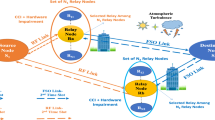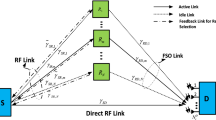Abstract
In this paper, the study of mixed radio frequency (RF)/ free space optical (FSO) communication decode and forward (DF) two way relaying (TWR) has been presented. In fact, it has been considered that multiple relays are present out of which the best operational relay is selected as per the partial relay selection (PRS) methodology in the presence of outdated channel state information (CSI). Importantly, the relay nodes are assumed to operate in the presence of in phase (I) quadrature phase (Q) imbalance (IQI). The atmospheric turbulence on the FSO link has been modeled using the Malaga distribution with pointing errors. In addition to this, the impact of type of optical demodulation has been considered in the analysis. For the system model, outage probability expression has been derived in terms of Meijer-G and Fox’s H-functions. In addition to this, for the TWR system, the outage probability expressions have been modified to present asymptotic results in terms of elementary functions. The numerical analysis of the research work suggests that the overall mixed RF/FSO DF TWR system is impacted by the image rejection ratio (IRR) due to IQI, correlation between outdated CSI, atmospheric turbulence, pointing error and type of optical demodulation in addition to the amount of fading on the RF link.




Similar content being viewed by others
Availability of data and material
Data sharing not applicable to this article as no datasets were generated or analyzed during the current study.
References
AlQuwaiee, H., Ansari, I.S., Alouini, M.S.: On the performance of free-space optical communication systems over Double Generalized Gamma channel. IEEE J. on Selec. Areas Commun. 33(9), 1829–1840 (2015)
Ansari, I.S., Yilmaz, F., Alouini, M.S.: Performance analysis of free-space optical links over \( \cal{M}\)\(\acute{a}\)laga (\( \cal{M}\)) turbulence channels with pointing errors. IEEE Trans. Wirel. Commun. 15(1), 91–102 (2016)
Balti, E., Guizani, M., Hamdaoui, B., Khalfi, B.: Mixed RF/FSO relaying systems with hardware impairments. In: GLOBECOM 2017—2017 IEEE Global Communications Conference, pp. 1–6 (2017)
Balti, E., Guizani, M., Hamdaoui, B., Maalej, Y.: Partial relay selection for hybrid RF/FSO systems with hardware impairments. In: 2016 IEEE Global Communications Conference (GLOBECOM), pp. 1–6 (2016)
Balti, E., Guizani, M., Hamdaoui, B., Khalfi, B.: Aggregate hardware impairments over mixed RF/FSO relaying systems with outdated CSI. IEEE Trans. Commun. 66(3), 1110–1123 (2018)
Dahrouj, H., Douik, A., Rayal, F., Al-Naffouri, T.Y., Alouini, M.-S.: Cost-effective hybrid RF/FSO backhaul solution for next generation wireless systems. IEEE Wirel. Commun. 22(5), 98–104 (2015)
Djordjevic, G., Petkovic, M., Cvetkovic, A., Karagiannidis, G.: Mixed RF/FSO relaying with outdated channel state information. IEEE J. Selec. Areas Commun. PP(99), 1–1 (2015)
Farid, A.A., Hranilovic, S.: Outage capacity optimization for free-space optical links with pointing errors. J. Lightwave Technol. 25(7), 1702–1710 (2007)
Gradshteyn, I.S., Ryzhik, I.M.: Table of Integrals, Series and Products. Academic, New York (2000)
Li, J., Matthaiou, M., Svensson, T.: I/Q imbalance in two-way AF relaying: power allocation and performance analysis. IEEE Trans. Commun. 62(7), 2271–2285 (2014)
Li, J., Matthaiou, M., Svensson, T.: I/Q imbalance in AF dual-hop relaying: performance analysis in Nakagami-\(m\) fading. IEEE Trans. Commun. 62(3), 836–847 (2014)
Mittal, P., Gupta, K.: An integral involving generalized function of two variables. Proc. Indian Acad. Sci.—Sect. A 75(3), 117–123 (1972)
Petkovic, M.I., Cvetkovic, A.M., Djordjevic, G.T., Karagiannidis, G.K.: Outage performance of the mixed RF/FSO relaying channel in the presence of interference. Wirel. Pers. Commun. Springer, 96, 2999–3014 (2017)
Qi, J., Aissa, S.: Analysis and compensation of I/Q imbalance in MIMO transmit-receive diversity systems. IEEE Trans. Commun. 58(5), 1546–1556 (2010)
Upadhya, A., Dwivedi, V.K., Singh, G.: Multiuser diversity for mixed RF/FSO cooperative relaying in the presence of interference. Opt. Commun. 442, 77–83 (2019)
Upadhya, A., Dwivedi, V.K., Alouini, M.S.: Interference-limited mixed MUD-RF/FSO two-way cooperative networks over double generalized Gamma turbulence channels. IEEE Commun. Lett. 442, 1551–1555 (2019)
Upadhya, A., Dwivedi, V.K., Karagiannidis, G.K.: On the effect of interference and misalignment error in mixed RF/FSO systems over generalized fading channels. IEEE Trans. Commun. 68(6), 3681–3695 (2020)
Upadhya, A., Gupta, J., Dwivedi, V.K., Alouini, M.-S.: Impact of RF I/Q imbalance on interference-limited mixed RF/FSO TWR systems with non-zero boresight error. IEEE Wirel. Commun. Lett. 10(2), 416–420 (2021)
Wolfram, I.: Wolfram, research, mathematica edition: Version 10.0. champaign, Wolfram Research, Inc. (2010)
Zedini, E., Ansari, I.S., Alouini, M.S.: Performance analysis of mixed Nakagami-\(m\) and Gamma Gamma dual-hop FSO transmission systems. IEEE Photonics J. 7(1), 1–20 (2015)
Acknowledgements
The author acknowledges the editor and anonymous reviewer for providing inputs that improved the quality of the manuscript.
Funding
No funding agency is involved in the research work.
Author information
Authors and Affiliations
Corresponding author
Ethics declarations
Conflict of interest
The authors have not disclosed any competing interests.
Additional information
Publisher's Note
Springer Nature remains neutral with regard to jurisdictional claims in published maps and institutional affiliations.
Appendices
Appendix A: Derivation of \(F_{{\gamma _{\mathrm{RS2}}}}(x)\)
In this section, the derivation of \(F_{{\gamma _{\mathrm{RS2}}}}(x)\) has been presented. From the definition of \(\gamma _{{\mathrm {{{RS2}}}}}(x)\) in (7), the expression for \(F_{{\gamma _{\mathrm{RS2}}}}(x)\) can be defined using the relationship
Substituting the requisites in the above integral, the expression for \(F_{{\gamma _{\mathrm{RS2}}}}(x)\) can be deduced as
The above integral can be further formulated as
Applying Wolfram (2010, Eq. (07.34.21.0013.01)), a closed-form solution to the integral can be obtained which yields the expression for \(F_{{\gamma _{\mathrm{RS2}}}}(x)\).
Appendix B: Derivation of \(F_{{\gamma _{\mathrm{RS2}}}}(x)\)
The overall CDF for \(\gamma _{RS1} \) can be evaluated as
Substituting the requites in the above expression, the above integral can be re-written as
For finding the solution to the integral, the Meijer-G function can be expressed in contour integral form as per Wolfram (2010, Eq. (07.34.02.0001.01)) as shown below
Placing from (1) to (2), the integral required to be attended can be framed as
Invoking identity (Wolfram 2010, Eq. (07.34.03.0271.01)), the integral can be again presented as follows
With the help of Wolfram (2010, Eq. (07.34.21.0088.01)), the solution to the above integral can be given as
In order to establish a closed-form solution, the relationship (Wolfram 2010, Eq. (07.34.02.0001.01)) can be used to express the Meijer-G function into complex integral form, and therefore, the above integral can be further represented as
Combining together, the results from (B.2) and (B.7), the overall expression for \(F_{{\mathrm {\gamma _{RS1}}}}(x)\) can be expressed in double contour integral form as given below
Comparing the obtained contour integral with the Mittal and Gupta (1972, Eq. (2.1)), the resulting CDF for \(F_{{\mathrm {\gamma _{RS1}}}}(x)\) can be expressed as bivariate Fox’s H-function as given in (16).
Rights and permissions
About this article
Cite this article
Mittal, S., Yadav, P.K. & Dwivedi, V.K. Partial relay selection for two-way mixed RF/FSO DF networks in the presence of I/Q imbalance. Opt Quant Electron 54, 369 (2022). https://doi.org/10.1007/s11082-022-03651-6
Received:
Accepted:
Published:
DOI: https://doi.org/10.1007/s11082-022-03651-6




